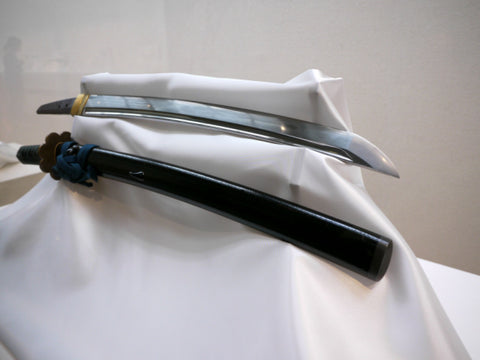Sengo Muramasa: Crafting Legends with the Sword
4 minute read
In the quiet village of Miyamoto, there lived a renowned swordsmith named Sengo Muramasa. He was known throughout the land for his unmatched skill in crafting blades that were not merely weapons but works of art. Yet, his greatest masterpiece was yet to come, one that would befit his most precious treasure: his samurai son, Kaito.
Kaito had always admired his father's craftsmanship. As a child, he would sit by the forge, watching Muramasa work tirelessly, his eyes filled with wonder. He dreamt of the day he would wield a blade forged by his father's hands.
One crisp autumn morning, Muramasa stood in his humble workshop, his calloused hands trembling slightly with anticipation. He had decided that it was time to create a sword that would be a reflection of his love for Kaito. This sword would not only be a weapon but a symbol of their unbreakable bond.
For weeks, Muramasa meticulously selected the finest materials. He chose Tamahagane steel for its purity, smelting it with the utmost care. He folded and hammered the steel countless times, coaxing it into the shape of a blade that would be both strong and flexible. With each strike, he poured his love and aspirations for his son into the metal.
The process was arduous, but he was relentless. He etched intricate patterns onto the blade, creating a stunning hamon, a reflection of his son's unwavering spirit. He wrapped the hilt with a silk cord, hand-dying it a deep shade of indigo, representing the depth of their connection. At last, he adorned the pommel with a small, glistening sapphire, symbolizing Kaito's courage.....
In the world of Japanese swordsmiths, few names evoke as much reverence and mystique as Sengo Muramasa. Born during the Muromachi period (approximately 14th to 16th century), Muramasa's legacy as a swordsmith has transcended centuries. His swords, renowned for their sharpness, craftsmanship, and unique characteristics, continue to captivate sword enthusiasts and historians alike.
The Life and Times of Sengo Muramasa
Sengo Muramasa was born in Ise Province in Japan. His exact birth and death dates remain shrouded in mystery, adding an element of intrigue to his story. Muramasa began his career as a swordsmith, likely as an apprentice to another master swordsmith. During this period, he honed his craft and developed the skills that would later define his legacy.
Muramasa went on to establish his own school of swordsmithing, which became known as the Muramasa School. This school produced not only Muramasa's signature blades but also trained other talented swordsmiths who continued his tradition. The school's distinctive style and techniques are a testament to Muramasa's ingenuity and influence on the art of swordmaking.
The Muramasa School continued to thrive even after the passing of its founder. Many skilled swordsmiths trained in the Muramasa tradition, ensuring the continued production of high-quality swords in his style. This influence can be seen in the work of subsequent generations of swordsmiths.
Muramasa's swords are celebrated for their unique characteristics and unparalleled craftsmanship. Here are some key elements that make his swords stand out:
Sharpness and Cutting Ability
Muramasa blades are famous for their exceptional sharpness and cutting ability. The swords' sharp edges are a result of Muramasa's meticulous craftsmanship and the use of high-quality steel. His swords were often said to be able to cut through multiple targets with ease, making them formidable weapons on the battlefield.
Distinctive Hamon
One of the most distinctive features of Muramasa's swords is their hamon, which is the wavy pattern along the blade's edge. Muramasa's hamon is characterized by its irregular and wild appearance, in contrast to the more controlled and uniform hamon of other swordsmiths. This unique hamon design adds to the allure of his swords and makes them easily recognizable.
Unconventional Reputation
Muramasa's blades gained a reputation for having a somewhat sinister quality. Legend has it that they had a tendency to "hunger for blood" and were cursed to bring misfortune to their owners. This reputation, while likely steeped in folklore, only added to the mystique surrounding Muramasa's swords.
Sengo Muramasa's legacy extends far beyond his lifetime. His swords have left an indelible mark on Japanese culture, history, and the art of swordmaking. Today, Sengo Muramasa's swords are highly sought after by collectors and enthusiasts worldwide. These prized blades often fetch exorbitant prices at auctions and are considered valuable cultural artifacts.
The day finally arrived when Masaru presented the sword to his son. Kaito's eyes widened in awe as he beheld the weapon, the embodiment of his father's love and dedication. He unsheathed the blade, and it sang with a melodious hum that seemed to resonate with his heart.
"It is a perfect blade, my son," Masaru said, his eyes glistening with pride. "May it serve as a reminder of the bond we share, and may it protect you on your journey as a samurai."
Kaito nodded, unable to find words to express his gratitude. He knew that this sword was more than a weapon; it was a testament to his father's love and faith in him.
Years passed, and Kaito became a respected samurai, his father's sword by his side in every battle. The blade moved effortlessly, its edge as sharp as their bond. Together, they faced countless challenges and emerged victorious.
In the end, it was not only the sword that was a masterpiece; it was the love between a father and a son, forged with the same dedication, strength, and resilience that went into crafting that perfect blade. Masaru's legacy lived on not just in his craftsmanship but in the heart and soul of his samurai son, Kaito.

